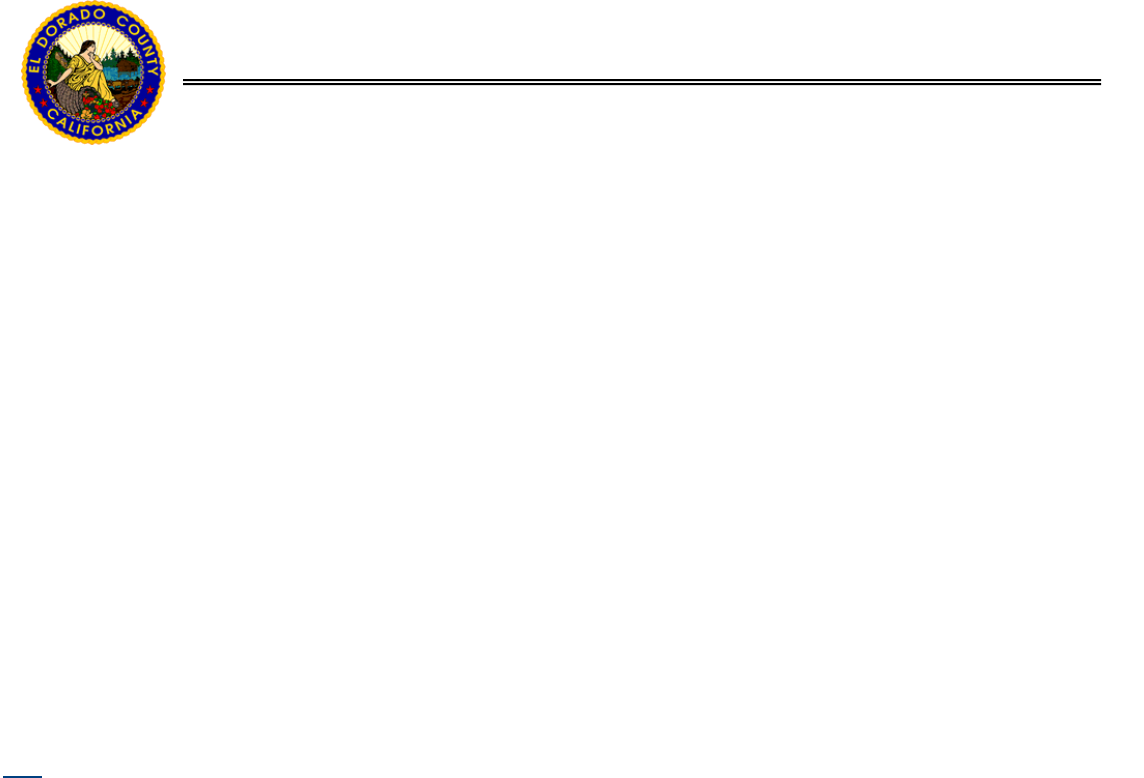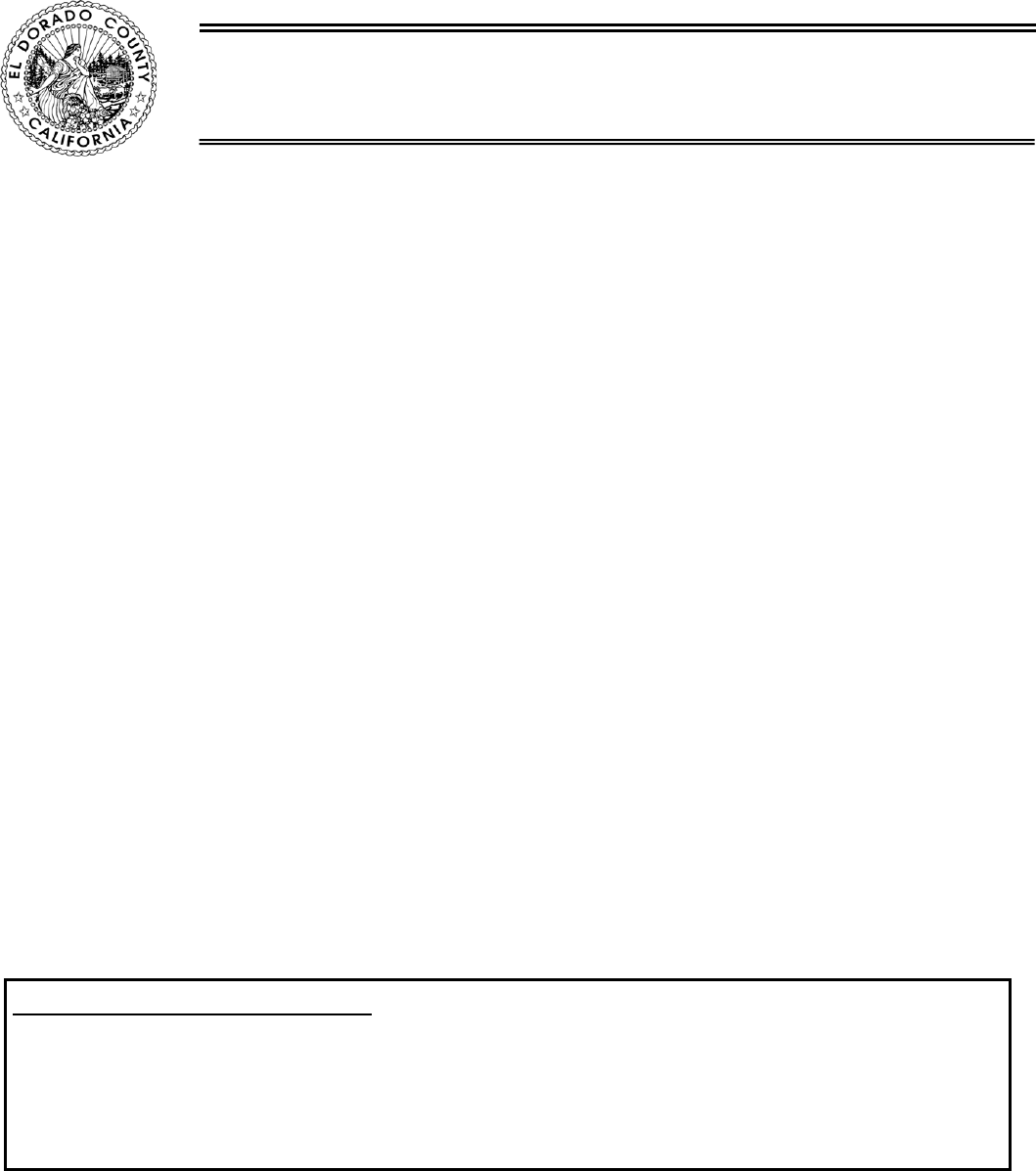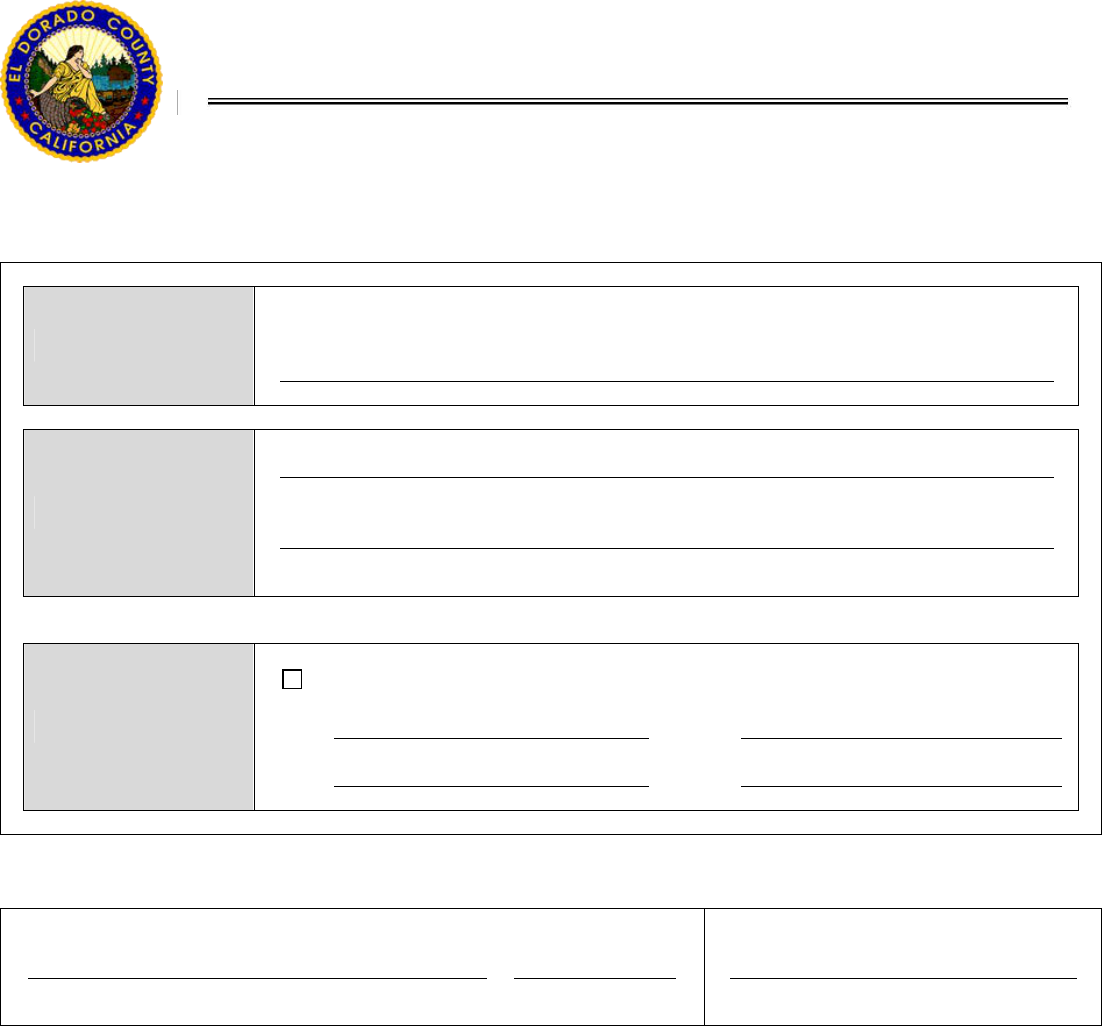
Caldor Fire
Assessor Information packet update – 8/27/2021
This information packet is as complete as we can provide at this time. The situation is fluid and affects
how the County processes reductions, adjusts assessed values and accepts applications for 2021/22 tax
bill payment deferral. Please note the following updates:
1) The first Installment of the 2021/22 property tax bill must be paid by the December 10, 2021
delinquency date to avoid penalties (and second installment by April 11, 2022). However, if
your property is reassessed by the Assessor to a lower amount due to the Caldor Fire, the
Auditor-Controller will issue a one-time ‘supplemental refund check’ payable to you in lieu of
changing the 2021/22 tax bill.
2) We cannot emphasize how important it is that if you receive a supplemental refund check, that
the money should be used to pay your 2021/22 property tax bill. If your mortgage company
pays the tax bill on your behalf, please discuss with your mortgage company if you need to
forward the check to them.
3) It is our intention to process and mail these supplemental refund checks before December 10. If
you receive a check prior to December 10, your 2021/22 property tax bill will not be eligible for
a tax bill payment deferral under §194.
4) If, for some unforeseen reason, our processing is delayed and you are not mailed a
supplemental refund check by the time the taxes are delinquent (December 10, 2021) then, and
only then, is the County able to accept requests for payment deferral under R&T Code §194.
5) If you purchased your property in 2021, your situation is different and may require special
handling. Please make sure we have an updated phone and email contact in case we need
additional information to process your property tax reduction.
6) If you were constructing your residence, or building an addition or had any new construction in
progress in 2021, your situation is different and may require special handling. Please make sure
we have an updated phone and email contact in case we need additional information to process
your property tax reduction.
Again, we emphasize that we are making every effort to quickly and efficiently adjust the 2021/22
property taxes for the damage that is occurring from the Caldor fire.

COUNTY OF EL DORADO
Karl Weiland, Assessor
OFFICE OF THE ASSESSOR
MAIN OFFICE - 360 FAIR LANE PLACERVILLE, CA 95667
TELEPHONE - PLACERVILLE (530) 621- 5719 – S.LAKE TAHOE (530) 573- 3422
FAX (530) 642- 8148 - ONLINE: www.edcgov.us/assessor
August 30, 2021
Dear property owner,
Please let me extend the condolences and sympathy from myself and the staff in the Assessor’s
office for the damage and loss you have suffered as a result of the Caldor fire. This letter explains
provisions of the property tax laws that provide property tax relief to the owners of damaged
properties and how the program works.
§170 of the Revenue & Taxation code provides that homes damaged in fires such as
Caldor will have the loss in market value reflected in a reduction of the assessed value and the
property taxes reduced accordingly.
This recognition will reduce your 2021/2022 net property tax obligation. The process will be as
follows:
1) The regular 2021/2022 Property Tax Bills have been published and by law, both
installments must be paid in full, however;
2) The County is moving as fast as conditions allow to process and mail refund checks that
will reduce the net property taxes for 2021/2022 to reflect the fire damage.
3) Our office will work to ensure that your property tax reductions, and the resulting refund
checks are processed as quickly as possible.
Also, under §170, rebuilding will not result in reappraisal by the Assessor’s Office. The property
owners can rebuild and keep the base year value at the time of the fire. The process works as
follows:
1) The property is damaged by a calamity such as the Caldor fire.
2) The Assessor processes a reduction in the assessment to recognize the loss in
value. In the case of Caldor, tax relief will be processed as soon as Cal fire
allows entry into the damaged areas. We will work with other agencies and
process the reductions as fast as possible.
3) The damaged property is built. Upon completion of construction, the Assessor
restores the value removed when the damage occurred. The only additional
value that is added is for additional square footage. Upgrades in quality/finish
to the original square footage are not considered. If the new construction is
larger than the building it is replacing, the Assessor adds the market value of
the additional square footage to the restored value.
Additional information is available in our Prop 170 Calamity Claim Guide.

In addition to a reduction in your 2021/2022 property taxes, there are provisions in property tax
law under which your property tax payment may be deferred. This deferral is not available to
property owners whose taxes are paid through an impound account. Because the County is
issuing refund checks and not new bills, this provision will only be available in very limited
circumstances. More information is available in our Property tax deferral guide.
And finally, there are provisions in the recently passed Prop 19 that allow you to transfer your
assessed value to a replacement home anywhere is California. For more information on this
option, please ask our staff for the Prop 19 Base year transfer guide.
I hope this information helps you understand the process. If you have any further questions,
please call our office at 530.621.5719, or send an email to assessor@edcgov.us. The Assessor
website has additional information and forms at edcgov.us/assessor
Sincerely
Karl Weiland
Assessor

COUNTY OF EL DORADO
Karl Weiland, Assessor
OFFICE OF THE ASSESSOR
1
MAIN OFFICE - 360 FAIR LANE PLACERVILLE, CA 95667
TELEPHONE - PLACERVILLE (530) 621- 5719 – S.LAKE TAHOE (530) 573- 3422
FAX (530) 642- 8148 - ONLINE: www.edcgov.us/assessor
Caldor Fire
Calamity reductions under §170
The text of §170 is printed below. Here are the highlights:
- The Governor has proclaimed a state of emergency in the County, so that requirement is met.
- The County has a qualifying ordinance on §170, so that requirement is met.
- Any property, real or personal, is eligible for relief.
- The minimum damage requirement is a $10,000 reduction in market value.
- Anyone can file an application. Please make sure good contact information is provided in case follow up is
necessary.
- When rebuilding starts, it will be assessed on each subsequent lien date and when finaled. A proportionate
portion of the previously removed assessed value will be added until the old assessed value is fully restored
on completion of construction.
- No value will be added for improvements in quality.
- The only permitted addition to the restored value will be the fair market value for any additional square
footage. In other words, if a bigger house is built, it will be treated as an addition.
CHAPTER 2.5. Disaster Relief [170 - 171]
( Chapter 2.5 added by Stats. 1979, Ch. 242. )
170.
(a) Notwithstanding any other law, the board of supervisors, by ordinance, may provide that every
assessee of any taxable property, or any person liable for the taxes thereon, whose property was
damaged or destroyed without his or her fault, may apply for reassessment of that property as
provided in this section. The ordinance may also specify that the assessor may initiate the
reassessment where the assessor determines that within the preceding 12 months taxable property
located in the county was damaged or destroyed.
To be eligible for reassessment the damage or destruction to the property shall have been caused by
any of the following:
(1) A major misfortune or calamity, in an area or region subsequently proclaimed by the Governor to
be in a state of disaster, if that property was damaged or destroyed by the major misfortune or
calamity that caused the Governor to proclaim the area or region to be in a state of disaster. As used
in this paragraph, “damage” includes a diminution in the value of property as a result of restricted
access to the property where that restricted access was caused by the major misfortune or calamity.
(2) A misfortune or calamity.
(3) A misfortune or calamity that, with respect to a possessory interest in land owned by the state or
federal government, has caused the permit or other right to enter upon the land to be suspended or
restricted. As used in this paragraph, “misfortune or calamity” includes a drought condition such as
existed in this state in 1976 and 1977.
The application for reassessment may be filed within the time specified in the ordinance or within 12
months of the misfortune or calamity, whichever is later, by delivering to the assessor a written
application requesting reassessment showing the condition and value, if any, of the property
immediately after the damage or destruction, and the dollar amount of the damage. The application
2
shall be executed under penalty of perjury, or if executed outside the State of California, verified by
affidavit.
An ordinance may be made applicable to a major misfortune or calamity specified in paragraph (1) or
to any misfortune or calamity specified in paragraph (2), or to both, as the board of supervisors
determines. An ordinance shall not be made applicable to a misfortune or calamity specified in
paragraph (3), unless an ordinance making paragraph (2) applicable is operative in the county. The
ordinance may specify a period of time within which the ordinance shall be effective, and, if no period
of time is specified, it shall remain in effect until repealed.
(b) Upon receiving a proper application, the assessor shall appraise the property and determine
separately the full cash value of land, improvements and personalty immediately before and after the
damage or destruction. If the sum of the full cash values of the land, improvements and personalty
before the damage or destruction exceeds the sum of the values after the damage by ten thousand
dollars ($10,000) or more, the assessor shall also separately determine the percentage reductions in
value of land, improvements and personalty due to the damage or destruction. The assessor shall
reduce the values appearing on the assessment roll by the percentages of damage or destruction
computed pursuant to this subdivision, and the taxes due on the property shall be adjusted as
provided in subdivision (e). However, the amount of the reduction shall not exceed the actual loss.
(c) (1) As used in this subdivision, “board” means either the county board of supervisors acting as the
county board of equalization, or an assessment appeals board established by the county board of
supervisors in accordance with Section 1620, as applicable.
(2) The assessor shall notify the applicant in writing of the amount of the proposed reassessment.
The notice shall state that the applicant may appeal the proposed reassessment to the board within
six months of the date of mailing the notice. If an appeal is requested within the six-month period,
the board shall hear and decide the matter as if the proposed reassessment had been entered on the
roll as an assessment made outside the regular assessment period. The decision of the board
regarding the damaged value of the property shall be final, provided that a decision of the board
regarding any reassessment made pursuant to this section shall create no presumption as regards the
value of the affected property subsequent to the date of the damage.
(3) Those reassessed values resulting from reductions in full cash value of amounts, as determined
above, shall be forwarded to the auditor by the assessor or the clerk of the board, as the case may
be. The auditor shall enter the reassessed values on the roll. After being entered on the roll, those
reassessed values shall not be subject to review, except by a court of competent jurisdiction.
(d) (1) If no application is made and the assessor determines that within the preceding 12 months a
property has suffered damage caused by misfortune or calamity that may qualify the property owner
for relief under an ordinance adopted under this section, the assessor shall provide the last known
owner of the property with an application for reassessment. The property owner shall file the
completed application within 12 months after the occurrence of that damage. Upon receipt of a
properly completed, timely filed application, the property shall be reassessed in the same manner as
required in subdivision (b).
(2) This subdivision does not apply where the assessor initiated reassessment as provided in
subdivision (a) or (l).
(e) The tax rate fixed for property on the roll on which the property so reassessed appeared at the
time of the misfortune or calamity, shall be applied to the amount of the reassessment as determined
in accordance with this section and the assessee shall be liable for: (1) a prorated portion of the taxes
that would have been due on the property for the current fiscal year had the misfortune or calamity
not occurred, to be determined on the basis of the number of months in the current fiscal year prior
3
to the misfortune or calamity; plus, (2) a proration of the tax due on the property as reassessed in its
damaged or destroyed condition, to be determined on the basis of the number of months in the fiscal
year after the damage or destruction, including the month in which the damage was incurred. For
purposes of applying the preceding calculation in prorating supplemental taxes, the term “fiscal year”
means that portion of the tax year used to determine the adjusted amount of taxes due pursuant to
subdivision (b) of Section 75.41. If the damage or destruction occurred after January 1 and before
the beginning of the next fiscal year, the reassessment shall be utilized to determine the tax liability
for the next fiscal year. However, if the property is fully restored during the next fiscal year, taxes
due for that year shall be prorated based on the number of months in the year before and after the
completion of restoration.
(f) Any tax paid in excess of the total tax due shall be refunded to the taxpayer pursuant to Chapter 5
(commencing with Section 5096) of Part 9, as an erroneously collected tax or by order of the board of
supervisors without the necessity of a claim being filed pursuant to Chapter 5.
(g) The assessed value of the property in its damaged condition, as determined pursuant to
subdivision (b) compounded annually by the inflation factor specified in subdivision (a) of Section 51,
shall be the taxable value of the property until it is restored, repaired, reconstructed or other
provisions of the law require the establishment of a new base year value.
If partial reconstruction, restoration, or repair has occurred on any subsequent lien date, the taxable
value shall be increased by an amount determined by multiplying the difference between its factored
base year value immediately before the calamity and its assessed value in its damaged condition by
the percentage of the repair, reconstruction, or restoration completed on that lien date.
(h) (1) When the property is fully repaired, restored, or reconstructed, the assessor shall make an
additional assessment or assessments in accordance with subparagraph (A) or (B) upon completion of
the repair, restoration, or reconstruction:
(A) If the completion of the repair, restoration, or reconstruction occurs on or after January 1, but on
or before May 31, then there shall be two additional assessments. The first additional assessment
shall be the difference between the new taxable value as of the date of completion and the taxable
value on the current roll. The second additional assessment shall be the difference between the new
taxable value as of the date of completion and the taxable value to be enrolled on the roll being
prepared.
(B) If the completion of the repair, restoration, or reconstruction occurs on or after June 1, but before
the succeeding January 1, then the additional assessment shall be the difference between the new
taxable value as of the date of completion and the taxable value on the current roll.
(2) On the lien date following completion of the repair, restoration, or reconstruction, the assessor
shall enroll the new taxable value of the property as of that lien date.
(3) For purposes of this subdivision, “new taxable value” shall mean the lesser of the property’s (A)
full cash value, or (B) factored base year value or its factored base year value as adjusted pursuant to
subdivision (c) of Section 70.
(i) The assessor may apply Chapter 3.5 (commencing with Section 75) of Part 0.5 in implementing
this section, to the extent that chapter is consistent with this section.
(j) This section applies to all counties, whether operating under a charter or under the general laws of
this state.
(k) Any ordinance in effect pursuant to former Section 155.1, 155.13, or 155.14 shall remain in effect
according to its terms as if that ordinance was adopted pursuant to this section, subject to the
limitations of subdivision (b).

4
(l) When the assessor does not have the general authority pursuant to subdivision (a) to initiate
reassessments, if no application is made and the assessor determines that within the preceding 12
months a property has suffered damage caused by misfortune or calamity, that may qualify the
property owner for relief under an ordinance adopted under this section, the assessor, with the
approval of the board of supervisors, may reassess the particular property for which approval was
granted as provided in subdivision (b) and notify the last known owner of the property of the
reassessment.
(Amended by Stats. 2014, Ch. 134, Sec. 2. (SB 1464) Effective January 1, 2015.)

COUNTY OF EL DORADO
Karl Weiland, Assessor
OFFICE OF THE ASSESSOR
1
MAIN OFFICE - 360 FAIR LANE PLACERVILLE, CA 95667
TELEPHONE - PLACERVILLE (530) 621- 5719 – S.LAKE TAHOE (530) 573- 3422
FAX (530) 642- 8148 - ONLINE: www.edcgov.us/assessor
Caldor Fire
Property Tax Deferral under §194
The text of §194.1 is printed below. Here are the highlights:
- The Governor has proclaimed a state of emergency in the County, so that requirement is met.
- The County has a qualifying ordinance on §170, so that requirement is met.
- A claim must be filed with the Assessor. - §194 (e), §194.1(a)
- There is no BOE form for filing a claim under this section. Therefore, the §170 claim form includes a check
box to request a claim for relief under these provisions.
- Anyone interested or desiring to file a claim for deferral needs to complete the §170 form and check the box
indicating the application is also a claim for deferral under these provisions.
- Deferral is not available to property tax payments made through an impound account. -§194.1(d)
- The damage requirement for a principal residence is 10% of value or $10,000, whichever is less. -§194(f)
- The damage requirement for all other property is 20%. §194(f)
- The Assessor will take an application from anyone who files. Please ensure good contact information is
provided for any follow up that may be necessary.
CHAPTER 5. Disaster Relief: Tax Deferral [194 - 196.99]
( Chapter 5 added by Stats. 1988, Ch. 1507, Sec. 14. )
194.
As used in this chapter:
(a) “Eligible county” means a county that meets both of the following requirements:
(1) Has been proclaimed by the Governor to be in a state of emergency.
(2) Has adopted an ordinance providing property tax relief for disaster victims as provided in Section
170.
(b) “Eligible property” means real property and any manufactured home, including any new
construction that was completed or any change in ownership that occurred prior to the date of the
disaster that meets both of the following requirements:
(1) Is located in an eligible county.
(2) Has sustained substantial disaster damage and the disaster resulted in the issuance of a state of
emergency proclamation by the Governor.
“Eligible property” does not include any real property or any manufactured home, whether or not it
otherwise qualifies as eligible property, if that real property or manufactured home was purchased or
otherwise acquired by a claimant for relief under this chapter after the last date on which the disaster
occurred.
(c) “Fair market value” means “full cash value” or “fair market value” as defined in Section 110.
(d) “Next property tax installment payment date” means December 10 or April 10, whichever date
occurs first after the last date on which the eligible property was damaged.
(e) “Property tax deferral claim” means a claim filed by the owner of eligible property in conjunction
with, or in addition to, the filing of an application for reassessment of that property pursuant to
Section 170, that enables the owner to defer payment of the next installment of taxes on property on

2
the regular secured roll for the current fiscal year, as provided in Section 194.1 or to defer payment
of taxes on property on the supplemental roll for the current fiscal year, as provided in Section 194.9.
(f) “Substantial disaster damage,” as to real property located in a county declared to be a disaster by
the Governor, means, with respect to real property and any manufactured home that has received the
homeowners’ exemption or is eligible for the exemption as of the most recent lien date, damage
amounting to at least 10 percent of its fair market value or ten thousand dollars ($10,000), whichever
is less; and, with respect to other property, damage to the parcel of at least 20 percent of its fair
market value immediately preceding the disaster causing the damage.
(Amended by Stats. 2003, Ch. 471, Sec. 9. Effective January 1, 2004.)
194.1.
(a) Any owner of eligible property who files on or before the next property tax installment payment
date, as defined in Section 194, a claim for reassessment pursuant to Section 170, or whose property
is otherwise reassessed pursuant to Section 170, may, in conjunction with the claim for
reassessment, apply to the county assessor to defer payment of that installment of property taxes on
the regular secured roll for the current fiscal year with respect to that property which are due no later
than that date which immediately follows the disaster which resulted in substantial disaster damage.
(b) If, pursuant to Section 170, a timely claim for deferral is filed, the payment shall be deferred
without penalty or interest until one of the following occur:
(1) The assessor has reassessed the property and a corrected bill prepared pursuant to Section 170
has been sent to the property owner. Taxes on the corrected tax bill deferred pursuant to this
paragraph are due and payable for the current year taxes on either December 10 for the first
installment or April 10 for the second installment, or 30 days after the date that the bill is mailed or
electronically transmitted to the owner, whichever is later. If the taxes on the corrected bill are
unpaid thereafter, the taxes become delinquent as provided in Section 2610.5 and shall be subject to
the penalty provided by law.
(2) The assessor has determined that the property is not eligible to be reassessed pursuant to Section
170, and the assessor has so notified the property owner. Taxes deferred pursuant to this paragraph
are due and payable for the current year taxes on either December 10 for the first installment or April
10 for the second installment, or within 30 days of the latter of the date of mailing printed on the
assessor’s notice or the postmark date on the assessor’s notice, whichever is later. If deferred taxes
are unpaid thereafter, the taxes become delinquent as provided in Section 2610.5 and shall be
subject to the penalty provided by law.
(c) If, following reassessment pursuant to subdivision (a), the assessor determines that an owner
who applied and was granted a deferral of property taxes did not file the claim in good faith, the
owner shall be assessed a delinquency penalty for the nonpayment of the deferred taxes.
(d) This section does not apply to property taxes paid through impound accounts.

COUNTY OF EL DORADO
Karl Weiland, Assessor
OFFICE OF THE ASSESSOR
1
MAIN OFFICE - 360 FAIR LANE PLACERVILLE, CA 95667
TELEPHONE - PLACERVILLE (530) 621- 5719 – S.LAKE TAHOE (530) 573- 3422
FAX (530) 642- 8148 - ONLINE: www.edcgov.us/assessor
Caldor Fire
Base year transfers under Prop 19
The text of LTA 2021/026-BASE YEAR VALUE TRANSFERS FOR GOVERNOR-PROCLAIMED DISASTERS is
printed below. Here are the highlights:
- The Governor has proclaimed a state of emergency in the County, so that requirement is met.
- Transferring a base year value under the calamity provisions requires the damaged property be sold in its
damaged state.
- There are no provisions that would preclude rebuilding the damaged property, selling it and applying for a
regular, i.e. non calamity or disability base year transfer. However, that transfer would count as one of the
three allowable regular transfers.
- All the regular Prop 19 rules apply to the transfer.
Section 2.1 of Article XIII A of the California Constitution (Proposition 19) Operative as of April 1, 2021,
§2.1(b) of article XIII A allows an owner of a primary residence who is a victim of a wildfire or natural disaster to
transfer the taxable value of their primary residence (original primary residence) to a replacement primary residence
that is purchased or newly constructed as that person's principal residence within two years of the sale of the original
primary residence, regardless of the location or value.
The specific requirements of section 2.1(b) include:
• The wildfire or natural disaster must result in a Governor-proclaimed state of emergency.
• The original primary residence improvements must have sustained physical damage amounting to more than 50
percent of its full cash value immediately prior to the wildfire or natural disaster.
• The damaged or destroyed property must have been the principal place of residence of the claimant as of the date
that property was substantially damaged or destroyed.
• The original primary residence must be sold in its damaged state.
• The replacement primary residence must be purchased or newly constructed within two years of the sale of the
original primary residence.
• The replacement primary residence may be located anywhere in California.
• The replacement primary residence must be the principal place of residence of the claimant.
• A claim for relief must be filed with the Assessor of the county in which the replacement property is located. The
claim must be filed within three years of the purchase or new construction of the replacement property to receive
relief as of the latest qualifying transaction. If this period is missed, prospective relief is available for the lien date of
the assessment year in which the claim is filed. The purchase of the replacement primary residence must occur
within two years of the sale of the original primary residence in its damaged state. The date of the misfortune or
calamity does not have to occur within two years of the date of sale or the date of purchase. For example, if a
principal residence was destroyed in 2017 and the vacant lot sold in 2021, the property owner would have two years
from the 2021 sale date to purchase a qualifying replacement primary residence.
For property that has been damaged or destroyed, the base year value that is transferred is the adjusted base year
value immediately prior to the date of damage or destruction of the original primary residence, plus any inflation
factoring for the period between the destruction and the purchase of the replacement primary residence. The date
the base year value is transferred is the date of the latest qualifying transaction—the sale of the original primary

2
residence, the purchase of the replacement primary residence, or the completion of new construction of a new
replacement primary residence.
Proposition 19 provides that if the full cash value of the replacement primary residence on its date of purchase or
completion of new construction is equal or less than the full cash value of the original primary residence just prior to
the date of disaster, then the adjusted base year value of the original primary residence just prior to the date of
disaster, plus any applicable inflationary adjustments, is transferred to the replacement primary residence. However,
if the full cash value of the replacement primary residence is greater than the full cash value of the original primary
residence, then the difference in the two full cash values is added to the transferred adjusted base year value.

COUNTY OF EL DORADO
Karl Weiland, Assessor
OFFICE OF THE ASSESSOR
1
MAIN OFFICE - 360 FAIR LANE PLACERVILLE, CA 95667
TELEPHONE - PLACERVILLE (530) 621- 5719 – S.LAKE TAHOE (530) 573- 3422
FAX (530) 642- 8148 - ONLINE: www.edcgov.us/assessor
Caldor Fire
Property Tax FAQ’s
Q - What happens to my assessed value of my property?
A – The Assessor will be reappraising all property in the affected areas and lowering the
assessed value based on the damage suffered.
Q – What does reappraisal do to my property taxes?
A – The taxes you pay this fall and next spring will be based on the reduced value. If the
reductions can be processed quickly, new bills will be issued. If not, refunds will be issued.
Q – How much will my taxes go down?
A – It depends on your base year value and the amount of damage. As an example, if you paid
about $2,000 a year before and your house was completely burned, your taxes will probably
be lowered to between $500 - $750.
Q – How do I make sure I get my tax bill?
A – If your mailing address is changing, make sure to notify the Assessor here at the Local
Assistance Center, or stop by our offices, or fill out an online form.
Q – Can I delay paying my December bill until it is reduced?
A – If you are not using an impound account to make your property tax payments, complete
the claim form and check the box applying for a §194.1 deferral. Make sure we have a good
mailing address and we will review and process your request as fast as we can. At this time, we
believe that most qualified applications will be approved.
Q- What happens when I rebuild my house?
A – When you finish rebuilding, the Assessor will enroll the prior (old) assessed value. There
will be no reappraisal of the new construction that replaces destroyed improvements.
Q – What if I build a bigger house?
A – The fair market value of the additional square footage will be added to the old base year
value.
Q – What if I build a nicer house with better flooring, trim and cabinets?
A – Changes in quality will not be reappraised.
Q – What other information can the Assessor provide?
A – The Assessor maintains a property record for every parcel. Some of the information relates
to square footage, permit history and this information could be very important. Please do not
hesitate to stop by our Placerville Office and review the information about your property.
2
Q – How long do I have to rebuild?
A – As far as the Assessor is concerned, the restoration of your property will be reviewed each
year until complete. You should also ask this question of the County Building Services.
Q- Can I relocate to a different property and transfer my assessed value under Prop 19?
A – Yes, the Governors declaration of Emergency is the state authorization needed for
property owners to be eligible to transfer the assessed value of a calamity damaged principal
residence to a replacement. The Assessor’s web site will have updated information as this
process moves forward.
Q – Where are your offices and how do I contact you?
A - The main office in Placerville is located at 360 Fair Lane in the County Government
complex. Office hours are 8:00-5:00, Monday thru Friday. The phone number is 530.621.5719.
The Assessor’s web site is www.edcgov.us/assessor.

COUNTY OF EL DORADO
Karl Weiland, Assessor
360 Fair Lane • Placerville, CA 95667
Telephone: (530) 621-5719 • Fax: (530) 642-8148
Website: www.edcgov.us/assessor
OFFICE OF THE ASSESSOR
Section 170 Worksheet 8/25/2021
Application for Reassessment of Damaged or Destroyed Assessable Property
in excess of $10,000 (R&T Sec. 170)
(Application must be made within 12 months of the misfortune or calamity, or specific calamity ordinance, whichever is later.)
Filing Date: _____________________ Contact Phone Number ______________________
Owners Name ________________________ Assessor's Parcel Number ___________________
Mailing Address: _____________________________________________________________________
Property Address or Location: ___________________________________________________________
Date of Misfortune or Calamity: ________________________________________________________
Type of Misfortune or Calamity: ________________________________________________________
Property Destroyed or Damaged consisted of: ______________________________________________
___________________________________________________________________________________
Value Value Amount
Applicant Opinion of Value Before Damage After Damage of Damage*
Land _____________ ____________ __________
Improvement (Structure) _____________ ____________ __________
Personal Property _____________ ____________ __________
(Business Equip/Vessel/Aircraft)
(Do not include nonassessable items such as personal effects, household furnishings, or Business inventory.)
* Attach documentation (insurance adjustment estimates or statement from licensed contractor, etc.…).
Do you plan to replace or repair damage? Yes No
For Governor declared disaster only:
This application must be delivered to the Assessor on or before the next property tax installment date
(December 10 or April 10, as applicable) to defer payment of property taxes.
☐ Please treat this claim as a Property Tax Deferral Claim pursuant to California Revenue & Taxation
Code 194.1 (Does not apply to properties with impound accounts)
I hereby apply for reassessment of the property described above. I declare that I was the owner of the
property or had it in my possession and control at the time of loss, and that I am responsible for the
taxes. I certify (or declare) under penalty of perjury under the laws of the State of California, that the
forgoing and all information hereon, including any accompanying statements, or documents is true,
correct and complete to the best of my knowledge and belief.
Signed: ___________________________________________ Date:_________________

CHANGE OF ADDRESS
EL DORADO COUNTY
ASSESSOR’S OFFICE
360 FAIR LANE
PLACERVILLE, CA 95667
Please print – Last Name, First Name, Middle Initial
Owner’s Name
Number and Street or P.O. Box Number
City State Zip Code
New Address
(if more than 4 parcels, please list on reverse side)
APN: APN:
APN: APN:
Parcel(s)
Signature Date Eff. Addr. Chg. Date Phone Number
ASA001 REV. 05/2020
COUNTY OF EL DORADO
OFFICE OF THE ASSESSOR
Ka
rl Weiland, Assessor
MAIN OFFICE - 360 FAIR
LANE PLACERVILLE, CA 95667
TELEPHONE - PLACERVILLE (530) 621-5719 – SOUTH LAKE TAHOE (530) 573-3422
FAX (530) 642-8148 - ONLINE: www.edcgov.us/assessor
Clear Form
Print
